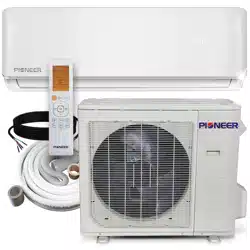Loading ...
Loading ...
Loading ...

Unit
Specifications
and Features
Page 7
Achieving Optimal Performance
Optimal performance for the COOL, HEAT, and DRY modes can be achieved in the following
temperature ranges. When your air conditioner is used outside of these ranges, certain safety
protection features will activate and cause the unit to perform less than optimally.
COOL mode HEAT mode DRY mode
Room Temperature
17°C - 32°C
(63°F - 90°F)
0°C - 30°C
(32°F - 86°F)
10°C - 32°C
(50°F - 90°F)
Outdoor
Temperature
0°C - 50°C
(32°F - 122°F)
-15°C - 30°C
(5°F - 86°F)
0°C - 50°C
(32°F - 122°F)
To further optimize the performance of your unit, do the following:
• Keep doors and windows closed.
• Limit energy usage by using TIMER ON and TIMER OFF functions.
• Do not block air inlets or outlets.
• Regularly inspect and clean air filters.
FOR OUTDOOR UNITS
WITH ELECTRIC HEATERS
(MOST ARCTIC VERSIONS)
Operational Temperature Ranges
When the outdoor
temperature is below 0°C
(32°F ), we strongly
recommend keeping the
unit energized at all
times to ensure smooth
and uninterrupted
performance.
COOL mode HEAT mode DRY mode
Room Temperature
17°C - 32°C
(63°F - 90°F)
0°C - 30°C
(32°F - 86°F)
10°C - 32°C
(50°F - 90°F)
Outdoor
Temperature
-15°C - 50°C
(5°F - 122°F)
-25°C - 30°C
(-12°F - 86°F)
0°C - 50°C
(32°F - 122°F)
Standard Models
Arctic (Low Ambient Temp.) Models
Full system-rated capacity and efficiency is obtained with the standard rating conditions as developed by the
testing and rating agencies. Deviations from rating conditions, especially atmospheric conditions, will be
compansated by the variable speed compressor, within certain limitations. Heat pump systems function
by exchanging energy, in the form of heat, between the indoor air and the outdoor ambient air (atmospheric).
The system’s net cooling or heating capacities and efficiencies change with atmospheric conditions, as well
as indoor air conditions (such as temperatures and humidity levels).
Capacity of the system required for a specific area or application must be determined professionally using
detailed calculations, which are based on several internal and external factors.
Loading ...
Loading ...
Loading ...
